Hi, everyone!
Earthly Paradise is going to be down overnight tonight (for readers in North America) while I switch to publishing on my own domain (apparently it takes a little while for the servers to update or whatever). The new address will be http://www.theearthlyparadise.com.
I've tried to do this a couple of times, but now I think I've got it all figured out! You will still be able to access this site from http://earthly-paradise.blogspot.com, but be sure to update your browsers as soon as possible. I will be emailing as many people as I can to let them know the new address.
Thanks for your patience, and have a great weekend everyone!
Margaret
Saturday, May 31, 2008
Announcing www.theearthlyparadise.com
Posted by
Margaret
at
5:25 PM
0
comments
![]()
![]()
Labels: blogging
Friday, May 30, 2008
The Medieval Mindset
I read a great opinion piece by David Brooks on the Medieval Mind in the New York Times about a month ago that I've been meaning to share. In it, Brooks bemoans the disenchantment that is the hallmark of the modern world. And while modern society has benefited from growing knowledge about the world that surrounds us, we have lost the sense of wonder and magic that seems so pervasive to the medieval worldview.
Brooks notes that, for the premoderns, the night sky was an "intimate and magical place." The heavens, to them, were a ceiling of moving spheres, rippling with signs and symbols, and moved by the love of God." C.S. Lewis once noted that the medieval world “was tingling with anthropomorphic life, dancing, ceremonial, a festival not a machine.” For us moderns, it is an expanse of "black, cold, mostly empty vastness, with planets and stars propelled by gravitational and other forces."
Brooks closes his article by reflecting on writers like C. S. Lewis and John Ruskin who "seized on medieval culture as an antidote to industrialism — to mass manufacturing, secularization and urbanization."
I sometimes wonder if knowledge must lead to disenchantment. I remember when I was a kid and I looked at the stars in the night sky in blissful ignorance. They looked so beautiful and ethereal in the night sky. I loved gazing at them. I even believed they would grant wishes (thank you Disney Pinocchio). Then a loving adult--I think it was my mom--informed me that the stars were actually just balls of gas. This was, um, not quite so romantic. It was like something snapped in my head. I continued to wonder at the beauty of nature, but it was a little depressing and disenchanting.
People often say that familiarity breeds contempt. I don't believe this is necessarily true--some things (and people!) you love even more as you get to know them better. But I also think that one of the reasons I love, say, my husband, even more as I spend more time with him, is because I believe he is more (pardon the expression) than just the some of his parts. I think that is one of the most important lessons that we can bring away from our medieval predecessors: there is more to this world than meets the eye.
Posted by
Margaret
at
5:56 AM
10
comments
![]()
![]()
Labels: c.s. lewis, medieval
Thursday, May 29, 2008
Getting Listed in the Open Directory Project
Time to reveal my nerdy side! It's taken several months and I had almost given up, but when I got back from France I realized that The Earthly Paradise is now listed in the Open Directory Project! Unfortunately, this blog's listing is already slightly out of date, since I submitted my application months ago, when I first started this blog. The Earthly Paradise has changed direction somewhat since then (i.e., this blog is listed as an "introduction to the arts and crafts movement" and I'm not that's any longer true, strictly speaking).
According to their website, The Open Directory Project is a "is the most comprehensive human edited directory of the Web, compiled by a vast global community of volunteer editors." Blah, blah, blah. Basically, it's a good website directory, and it's generally accepted that getting your blog or website listed with the ODP is a good thing. The downside is that it can take a while to get your site included (and you'll probably have to submit your blog yourself, unless someone is altruistic enough to do it for you). However, many claim that it's worth it in the long run. I, for one, can personally attest that I have noticed a slight increase in Google search traffic since getting listed, but nothing extraordinary.
What are your experiences with the ODP? I know some people hate it because they've had a hard time getting in. It does seem like a useful resource, though there are drawbacks as well. For example, since editors aren't paid, people speculate that competitors are often in charge editing the categories and purposefully exclude others. I didn't experience this, but that is probably because art weblogs aren't exactly a highly competitive niche at the moment! My experience might have been quite different were I, say, someone who blogged about SEO (search engine optimization, for those of you who aren't nerd wannabes, like me).
Any thoughts? Do any of you harbour closet nerdy tendencies, or am I the only one? I always figure most bloggers must have some interest in these sorts of things, since it takes a little bit of tech savvy to blog in the first place (but not much--I knew virtually zilch before I started this blog). I guess I'm just naturally curious, so I'm easily fascinated by these sorts of things. I'd love to hear your thoughts.
Posted by
Margaret
at
5:07 AM
6
comments
![]()
![]()
Labels: blogging
Wednesday, May 28, 2008
Medieval-Inspired Umbrella Stand from Musee D'Orsay
More from the Musee D'Orsay! (Can you tell I liked this place?).
This umbrella stand was in the same room as the pictures from yesterday's post. When I looked at the picture again today, I realized that the wrought iron designs on the bottom of this early 20th century stand were copied almost directly from iron works on display at the cluny museum from the 15th century. Do you see the resemblance?

Pretty neat, eh? One of my favourite things about art is how symbols and designs are picked up and re-used over time. It just shows that if you create something of lasting value, people will continue to be inspired by it for years to come (now, where can I find an umbrella stand like that?).
Posted by
Margaret
at
5:24 AM
3
comments
![]()
![]()
Labels: decorating, france, medieval, museums
Tuesday, May 27, 2008
Decorative Arts at the Musee D'Orsay
As I continue chronicling my visit to Paris earlier this month, I thought I'd take a moment to revisit the Musee D'Orsay and tell you a bit about their great collection of decorative arts.
I guess you can tell I've swallowed William Morris' philosophy hook, line and sinker because whenever I get to a museum, I instantly make a beeline for whatever decorative arts are on display. Of course I still love paintings and sculpture, but I've developed a special place in my heart for beautiful (and useful!) household objects.
The Musee D'Orsay is a paradise for anyone who loves Art Nouveau style. They have several rooms at the Musee D'Orsay entirely devoted to Art Nouveau art objects. My favourite was the room pictured below, which was a recreation of a sort of "Haute Art Nouveau" living space. It's breathtakingly beautiful. The nature-inspired designs are so fluid that the walls feel like they are alive. It's incredible how the intricate, delicate carvings and the stunning grain of the wood combine to create such a spectacular effect.
I'm in love with the built-in shelves!
I really loved this vase and table and the carvings on the wall behind. Doesn't the entire room look like it came from the "Rivendell" set from Lord of the Rings? (by the way, if you aren't familiar with Art Nouveau, but you're familiar with the Peter Jackson film version of Lord of the Rings, the set for Rivendell was inspired by Art Nouveau style). 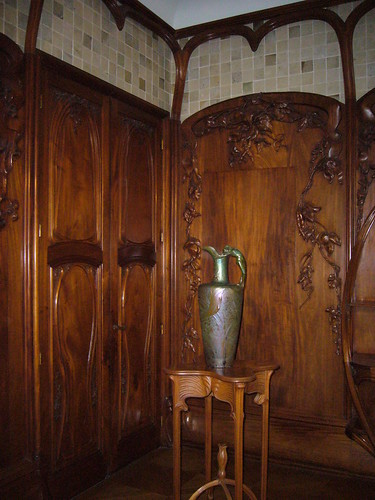
Posted by
Margaret
at
5:09 AM
6
comments
![]()
![]()
Labels: decorating, furniture, museums, william morris
Monday, May 26, 2008
Deluxe: How Luxury Lost its Lustre

I'm forever moaning about the demise of luxury--true luxury--which to me means hand crafted products made by people who are passionate about their art. And so, when I saw Dana Thomas being interviewed on Canada's Fashion Television about her new book Deluxe: How Luxury Lost its Lustre, I knew I had to read it! I bought it for the trip home from Paris and finished it in one sitting.
In the book, Thomas takes her readers on a tour behind the scenes of the world's best-known luxury brands. In the process, she reveals that many of the brands we associate with luxury and quality are actually anything but. Thomas details how luxury manufacturers cut corners to fatten up their bottom line through techniques like using cheap thread (Prada), shortening the sleeves on their suits, manufacturing goods in third world countries and then tearing out the labels and replacing them with ones that read "made in Italy" (Valentino) and making the uppers of their shoes in one country and the bottoms in Italy so that their products can legally read "made in Italy"(Prada again).
While Deluxe is critical of cost-cutting measures like having goods made in China, Louis Vuitton Moet Hennessy (LVMH) mastermind Jean Arnault comes across as the villain of the book for his aggressive business tactics (he routinely engages in hostile takeovers of family-owned businesses) and his way of re-invisioning luxury as focused on branding, rather than quality.
Thomas is particularly harsh on Louis Vuitton, Valentino and Georgio Armani , although very few luxury brands escape her critique. The one brand that seems to escape relatively unscathed is Hermes: their products may be overpriced, but they have held fast to their commitment to creating quality handcrafted objets d'art.
Dana Thomas also explores the world of fake luxury goods. In a world where brands are more prized than true quality, fakes are inevitable. People want a piece of the image they feel wearing a certain brand creates. Unfortunately, there is a real price for buying fakes--money from the sale of counterfeit goods supports organized crime and terrorist organizations like FARC in Colombia. Moreover, conditions in the factories where these goods are produced are MUCH, MUCH worse than in legal factories--since manufacturers are already breaking the law, there isn't much incentive for them to provide their workers with clean, safe working conditions. There was one truly horrific account of a counterfeit luxury manufacturer in Thailand who had broken the legs of his young workers when they said they wanted to go outside to play.
Deluxe is a must read for anyone who has ever wondered whether $700 shoes are really worth it or not (they aren't--and they probably aren't even really made in Italy). Her book proves that very few so-called "luxury products" deserve their exorbitant price tags. So, next time you are wishing you could afford couture clothes, pick up this book--you'll be glad you did.
cover image courtesy amazon.com
Posted by
Margaret
at
6:17 AM
6
comments
![]()
![]()
Saturday, May 24, 2008
Shopping in Paris at La Duree
La Duree's rose macaroons--my favourite flavour! 
On Wednesday the 14th my mom and I spent the day shopping for hostess gifts at Printemps and Galleries Lafayette. We were leaving for Rennes the next day to visit some wonderful friends my mom had made on her last trip. In the end, we came back with some AMAZING macaroons from La Duree. They made a great hostess gift--I think Monique was rather pleased, and I think everyone enjoyed eating the cookies!
I have to say that in spite of the jaw dropping cost of La Duree's desserts, they are definitely worth it. Each one is a little work of art! While we were there, we couldn't resist having some tea and cookies! I sampled their celebrated macaroons, while my mom had a spectacular confection--the Ipsahan--created by taking a rose macaroon, filling the center with rose cream and lychees, and decorating the entire thing with fresh raberries. Both were delicious (she graciously let me sample hers!). Mom's dessert was crowned with a fresh rose petal.
For tea I had "Marie Antoinette" tea (of course) and a sampler of four of their mini macaroons--violet cassis, pistachio, lemon and cherry. Each and ever one was a dream, but my favourite was the violet. After all, how often do you get to eat a violet-flavoured desserts? And it was not just interesting, it tasted spectacular and not at all weird. My other favourite was the rose, which my mom had (again, extremely tasty and strangely unstrange). The French seem to love not only having their flowers, but eating them, too--and they have certainly perfected the art!
This picture of us was taken at the La Duree Tea Room at Printemps by our extremely congenial waiter. It's a little blurry, but I'm glad to have it, since you aren't supposed to take pictures at La Duree!(I'm not sure why). 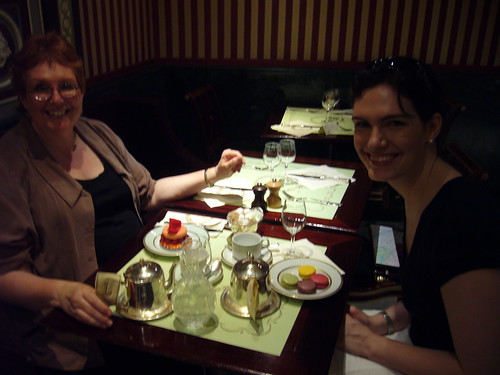
Afterwards we got stuck in a torrential downpour at a charming little cafe. Here you can see the Parisians dashing about madly in an attempt to escape the rain! I was really impressed at how many of them had umbrellas--it has been extremely hot for days and the rain came from nowhere. Parisians are well-prepared for whatever comes their way!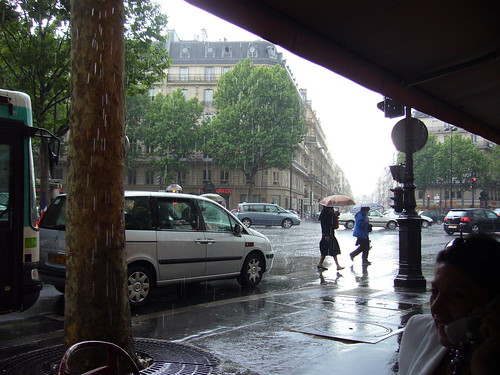
After we got back from Rennes, I decided to get my husband a box of macroons. They seemed like the perfect gift. I wasn't completely sure whether he would really appreciate them or not (after all, he's not a girl and I've never heard a guy gushing about La Duree). We sampled several of the macaroons on thursday and he LOVED them! (Of course, who wouldn't?).
Photo of rose macaroons courtesy of La Duree.
This post has been featured in Heather on Her Travels' Carnival of Europe.
Posted by
Margaret
at
7:00 AM
4
comments
![]()
![]()
Friday, May 23, 2008
Historic Pottery and Tiles at the Cluny Museum

My first day in Paris I went to the Cluny Museum. If you ever get a chance to go there, it's a must see! If you have any interest in medieval decorative arts, it is heaven. I was particularly impressed with their collection of pottery dating back to the 9th century, many of which were from Iran.
I was instantly struck by the similarities between the tiles in the Cluny and the work of William de Morgan during the late 19th century. I had learned a while ago that Morgan's work was inspired by Iznik (Turkish) and Persian ceramics, but this was the first time that I was able to see his inspiration up close. The similarities are striking!
I just love these two bowls. They are both from 9th century Iran and the colours and design work are just spectacular. I love the brilliant red that has been used in the first bowl. Pictures taken through glass are never very good, but hopefully you can still tell how bright the colours are. 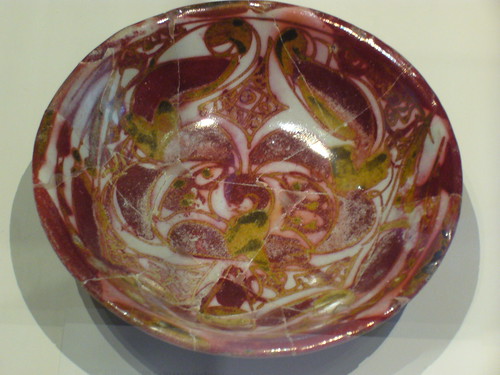
I find the design on the blue bowl quite reminiscent of some of William Morris' artichoke interpretations. Does anyone else agree? 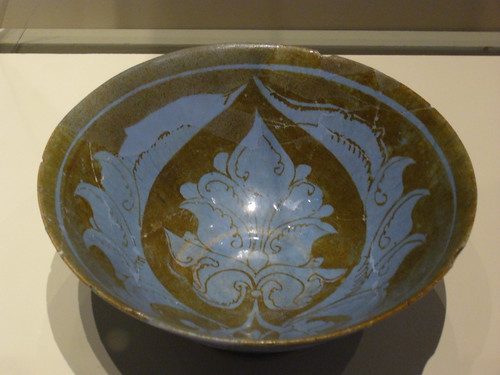
For comparison, this is one of William de Morgan's vases, which utilizes a bright red glaze whose formula was derived from analyzing fragments of medieval pottery from the Middle East. 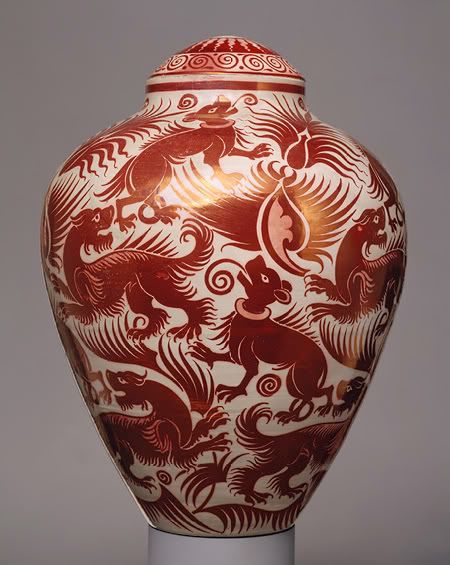
This tile from 9th century Iran uses a similar style and the bright colours are definitely reminiscent of de Morgan's work. 
Posted by
Margaret
at
7:10 AM
1 comments
![]()
![]()
Wednesday, May 21, 2008
Trip to Paris
Well, I got back from Paris really last night and I've been resting most of the day! I had such a spectacular trip and took tons of photos...There's definitely plenty to blog about!
I meant to write more during my last days in Paris, but it was pretty difficult. My mom and I were so busy the last few days just flew by. Now that I'm back, I plan to get back to my regular posting.
In other news, I had my blog spammed while I was gone and I have tons of work to do to clean it up (I'm almost finished, but like I said, it's a pain). As a result, I think I'm going to have to implement comment moderation, or at the very least add word verification. I hate to do it, because I personally find word verification a pain (I'm not so great at differentiating between letters and numbers!) and I like being able to see my comments on a blog immeadiately. Nevertheless, now I completely understand why everyone uses these tools. It can take hours to undo what a spammer can do in 10 minutes. I'm sure many have of you have had your own unfortunate experiences with these people...anyway, thankfully it wasn't any worse, and I guess I've learned my lesson.
I hope everyone is having a great week!
Posted by
Margaret
at
7:46 PM
3
comments
![]()
![]()
Saturday, May 17, 2008
Wolfsonian Museum in Miami

I'm always on the lookout for new places to go and see great art. I found out about the Wilfsonion Museum in Miami Beach just the other day and I had to share it with you.
The Wilfsonion Florida International University Museum in Miami Beach, Florida is one of the world's leading modern art museums, specializing in the period from 1885-1945. It also has the largest collection of art from the British Arts and Crafts Movement outside of England.
The Wilfsonian was founded in 1986 to house the art collection of Mitchell Wolfson Jr. The building and art collection were donated to Florida International University in 1997. The museum is filled with a tremendous variety of art objects, ranging from political propaganda from Mussolini's regime, to beautiful works from the Art Nouveau period.
This is one of those places I plan to visit the next time we go to Florida!
For more information on the Museum, rates and special events, visit the Wilfsonion-FIU website
Image courtesy the Florida International University Beacon Newspaper
Posted by
Margaret
at
7:30 AM
2
comments
![]()
![]()
Thursday, May 15, 2008
Decorating in Gothic Revival Style
Today I thought I'd do a feature on Medieval/Gothic interior decorating, with a couple of inspirational pictures from the Cluny Museum and Musee D'Orsay. Fear not! I'm not going to be discussing creepy black interiors or coffin-shaped beds. Remember, Gothic revival style is actually light, bright and inspired by nature.
So how do you capture a hint of the Medieval without looking like Count Dracula was your decorator? Well, William Morris' design work is a great example of Medieval revival done right. But if you'd like to capture some of those Gothic themes without using Morris as your template, here are some ideas.
Use colours inspired by nature. And focus both on colour and texture when choosing decorating fabrics. You want your room to feel luxurious, and beautifully textured fabrics are one of the best ways to do this. Of course, tapestries are the perfect touch, but they can be rather expensive! Also, a little hint: unless you have the great fortune of living in a castle constructed from brick or stone, your walls probably will need some added spice. Wallpaper adds a great touch, but it's easy to overdo. Please, please do not paint faux stones on your walls. It is the ultimate in tacky!
Here are some common medieval motifs that you might want to incorporate into your home: heraldic themes, such as fleur de lys, trellis designs, roses, lions, dragons and stylised crosses. Obviously, if you include all of these elements in one room it might look completely over the top. The key is simplicity--as always, stick by the tried and true William Morris maxim of avoiding everything that you don't "know to be useful or believe to be beautiful"--never ever fill your house with junk just because you think it somehow "goes" with your chosen decorating theme.
Although people always think Gothic style is about darkness, the opposite is true! Innovations in architecture in the early middle ages had allowed people to start allowing more light into their homes and public buildings. Obviously, one of the most popular ways of allowing light into churches was with stained glass. But stained glass windows can actually be used as a great decorating element in your home. You can find beautiful pieces in antique stores that have been removed from old buildings (it's tragic, I know, but you might as well take advantage of it). Light fixtures in wrought iron or pewter also look great in a Gothic revival home. Candelabras can evoke a more dark romantic mood, but if you keep the design light enough, it doesn't have to look depressing. Try to let in as much natural light as possible.
Furniture should be simple and constructed from natural elements. "Blobjects" are obviously a little more difficult to incorporate, though I have seen some very interesting design work that combines ultra modern plastic furniture with Gothic inspired architecture, but I wouldn't recommend it unless you really trust yourself as an interior designer. I saw this beautiful table at the Musee D'Orsay on Sunday. It's very much inspired by the simplicity of medieval furniture styles, but I love the delicate Art Nouveau interpretation.
For the bedroom: again, you will want to keep it simple. In the Middle Ages, most homes used simple pallets or four poster canopy beds. Wrought iron can look nice as well, but don't overdo it--you don't want your inner sanctum to resemble a dungeon (well, let's hope not).
Finally, resist the urge to collect and display tacky bits of medieval accouterments. I saw this box at the Cluny Museum on Saturday and I was so impressed with all of the delicate iron work! It took me a moment to realize that it was not factory produced--it would have taken an artisan ages to finish all of the design work. Obviously, this kind of time commitment would have made the piece extremely valuable--I doubt that people would have had their homes stuffed with trinkets--it simply was impossible, given how labour-intense the manufacture of these objects was. Something to keep in mind next time I'm tempted to buy something trendy!
True, William Morris had a suit of armour in his home, but then again, he was William Morris and could probably get away with it much more easily than you or I. Same goes for swords, etc.
Posted by
Margaret
at
7:06 AM
1 comments
![]()
![]()
Labels: decorating, travel
Tuesday, May 13, 2008
Musee D'Orsay
Paris is amazing--you could visit art exhibits for weeks before you ran out of things to do. On Sunday we went to the Musee D'Orsay, which was absolutely lovely. I didn't get a chance to go there last time and it was at the top of my list. All in all, it's one of my favourite things that I've done in Paris so far. They have a spectacular collection or artwork, including a good number of Symbolist paintings (this category is similar to, and often includes the Pre-Raphaelites). I even actually got to see one of my favourite Sir Edward Burne Jones paintings there, which is pictured below!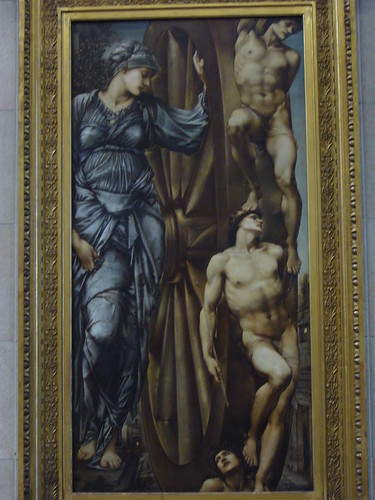
One of my favourite paintings at the Musee was actually this one, by Gustav Klimt ("The Kiss" is probably his most famous painting). It's called "Rosiers sous les Arbres" and I just adored it. I believe that I've seen the painting on notecards before, but it is sooo much better in person. 
The same also goes for the Monets. If you like Monet, Musee D'Orsay is a great place to go--they have so many, and they're so good! I have to admit that I always considered Monet somewhat bland before. Well, no more! They are absolutely fabulous! I tried taking pictures, but I've decided not to post them, because they seriously don't do justice to the paintings (that sounds so elitist, but it's simply true. It feels like taking a photo of Joshua Bell playing Mozart and calling it a great piece of music...). At any rate, Monet is definitley meant to be seen, not photographed. Which is really too bad, since he is so popular.
One picture I've included anyway is this one by Van Gogh. It's called Fritillaire Couronne Imperiale (1886). I do hope I spelled it right! I just loved it. Van Gogh is another artist that I've decided is just not fair to reproduce in print. There's simply too much texture in his paintings to reproduce them in photos. Ah well! I've done my best!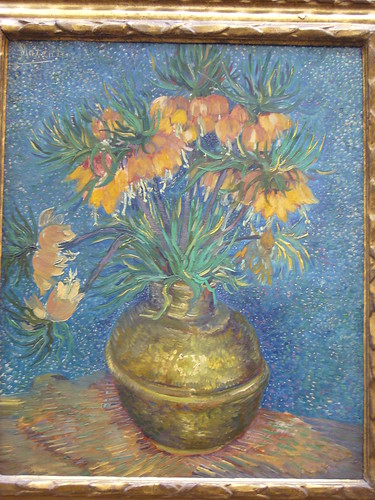
I hope everyone is having a great week! I'll post more later!
Posted by
Margaret
at
7:01 AM
4
comments
![]()
![]()
Monday, May 12, 2008
The Cluny Museum
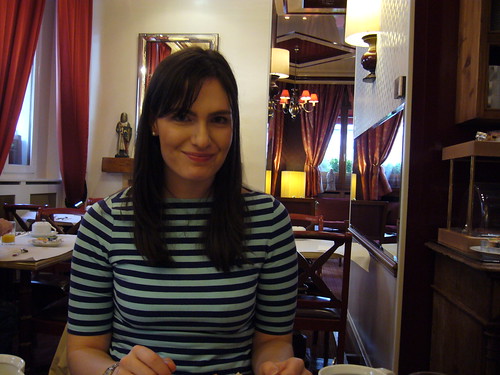
Greetings from Paris! I am having such a good time. The last few days have gone by so quickly. Paris is just lovely right now. The weather here is amazing, though quite a bit warmer than I had expected. This is a picture of me (after hours of flying and not a wink of sleep) just after arriving at the Hotel College du France. In the picture I'm having a cafe au lait and croissant which explains my mouth being full of food!
This is a picture from the Cluny Museum. I was very interested in the sculptures and tiles they had in their collection--some of the designs were so similar to ones that William Morris revived during the Arts and Crafts Movement ( actually found one 16th century acanthus carving that looked EXACTLY like the pattern Morris always used, but the light was too low to take a proper picture. I swear he must have traced it). We went to the Cluny right after breakfast on the 10th (Saturday). As fate would have it, it turned out that Saturday was free admission day--yay!--and it's a good thing, too. Prices in Paris have absolutely gone through the roof. The first time I came here I thought Paris was a bargain--well, no longer! (we had breakfast at a rather modest cafe the next day and I noticed that a coca cola was 8 euros--twelve dollars!)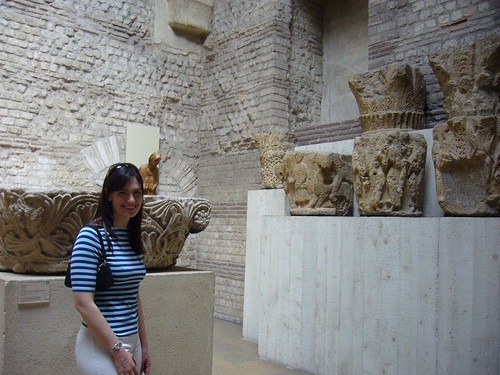
The Cluny was spectacular. A must for anyone who loves the Middle Ages--especially if they are into tapestries! They have the entire Lady and the Unicorn series there, and it is absolutely amazing to see up close, though unfortunately it's pretty much impossible to take photos, since there's no flash allowed and the room they are in keeps them in low light to preserve the colour. It really is a good thing in the long run, though, because it will preserve these fantastic works of art for another generation. One thing I was really impressed with when I saw them up close was how good the shading is. The figures seem so lively and there is so much humor injected into all of the tapestries. Definitely not the dreary mood you might imagine. My favourite from the series was "Gout" (taste). I will post a picture of it when I find a good one--such a great tapestry! Because of the light, I didn't get any tapestry picture that turned out very well, but this is for Kate! It doesn't nearly do justice to the amazing colours and textures, but c'est la vie!
Posted by
Margaret
at
9:03 AM
8
comments
![]()
![]()
Saturday, May 10, 2008
Oscar Wilde on Ruskin
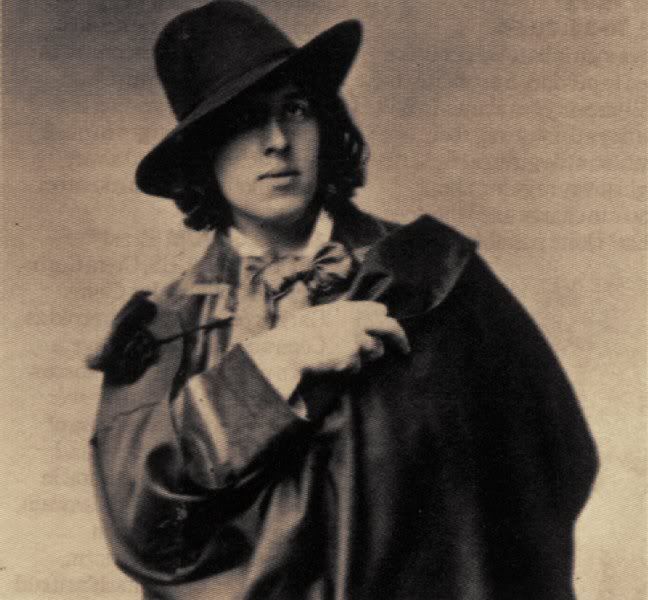
I've been an Oscar Wilde fan for as long as I can remember. I instantly fell in love with his flippant, irreverent humour. His quotable quotes are everywhere--I particularly love this one: "work is the curse of the drinking classes." So outrageous! How can you not love him?
In addition to his witty sayings and flamboyant excesses, Oscar Wilde is also very well known for his involvement in the aesthetic movement (which partially explains his penchant for velvet kneebritches). But did you know that Oscar Wilde was also a huge fan of John Ruskin?
Ruskin (then Slade Professor of Fine Art at Oxford) was one of the two people that Wilde most wanted to meet when he went to Oxford. Wilde befriended Ruskin during his first year at school after going to Ruskin's lectures of Florentine Art in the fall of 1874. Soon Wilde was he even helped Ruskin to plant flowers while constructing a country road in North Hinksey outside of Oxford! For several months, Wilde got up early in the morning to wheel "Mr. Ruskin's especial wheelbarrow." I personally find it a little difficult to imagine Oscar Wilde pushing a wheelbarrow and digging ditches. He must have been truly eager to impress Ruskin! It paid off though...Ruskin invited the students who helped him with his project were invited to breakfast afterwards, and I'm sure Wilde took advantage of the opportunity to talk with Ruskin.
Ruskin's ideas left a lasting impression on Wilde, who rose to his defense in his work Intentions. His defense of Ruskin was later republished in the New York Times in 1891.
Who cares whether Mr. Ruskin's views on Turner are sound or not? What does it matter? That mighty and majestic prose of his so fervid and so fiery coloured in its noble eloquence, so rich in its symphonic music, so sure and certain, at its best in subtle choice of word and epithet, is at least as great a work of art as any of those sunsets that bleach or rot on their corrupted canvases in England's gallery; greater, indeed, one is apt to think at times, not merely because its equal beauty is more enduring, but on account of the fuller variety of its appeal, soul speaking to soul in those long-cadenced lines, not through form and colour alone, though through these, indeed, completely and without loss, but with intellectual and emotional utterance, with lofty passion and with loftier thought, with imaginative insight and with poetic aim; greater I think even as literature is the greater art.
Oh, Oscar.
sources consulted: "Noted with Pleasure" from the New York Times
Posted by
Margaret
at
7:24 AM
0
comments
![]()
![]()
Labels: philosophy
Friday, May 9, 2008
The Last Time I Saw Paris
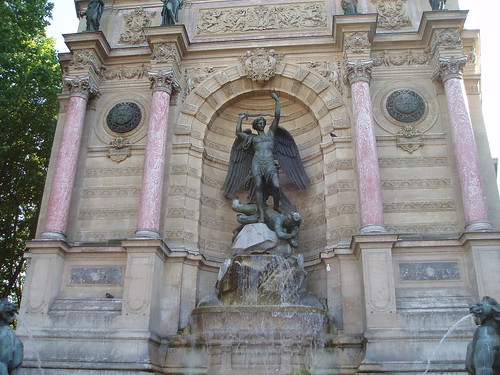
Well, I'm flying to Paris today! It's going to be a long flight, so I'll have plenty of time to brush up on my French! I've really been looking forward to this trip and I can hardly wait to see Paris.
The last time I saw Paris was the Summer of 2006. I'd just finished my first year at the University of Alberta and I was engaged. I was so excited to see Paris for the first time (but I was a little scared too! What if I didn't like Paris? What if the people were rude, like you always here? I fell in love with the city the minute I walked out of the Metro and saw the city for the first time. This picture captures that moment. Except I can't remember what this fountain is called. Does anyone know? Please, please leave a comment and remind me, all you francophiles.
I often tell people that Paris is like Disneyland for grownups. At least for grownups who love beautiful things. In the core of the city, everything is breathtakingly gorgeous. I could write a sonnet about every bridge! (There's an idea). And the people are charming. I think the myth that Parisians are rude was created by people who love Paris just to keep the city from becoming overcrowded with tourists. I don't think it has worked, but imagine how busy the city would be if everyone knew how nice the people actually are?
When I get to Paris, the first thing I will do (after taking a shower--I will have been traveling for 24 hours!) is have a lovely Parisian breakfast. Perhaps a Pain au Chocolat with cafe au lait. Then I'm off to the Cluny Museum to look at their collection of Medieval art (something I didn't get to do last time).
I will be doing my best to post while I'm in France. I have some posts scheduled just in case I'm too busy having a good time to get to chain myself to a computer. In any event, I will be keeping a diary and taking dozens of photos, so I'll definitely post a daily account of my trip when I get back!
Have an amazing weekend, everyone!
Posted by
Margaret
at
7:42 AM
3
comments
![]()
![]()
Labels: travel
Thursday, May 8, 2008
Chateau de Chantilly
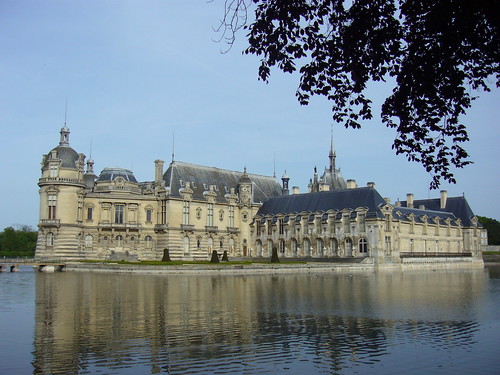
My mom took this lovely photo of Chateau de Chantilly a few days ago. Isn't it beautiful? The Chateau rests on a spectacular 7800 hectare estate and is filled with spectacular art treasures. The gardens are amazing and even the stables are palatial!
I'm going to try and drop off my thesis to my readers this morning, so I'm pretty busy, but I'm also trying to create an itinerary of all the places I want to go this trip.
Places I have to go:
Arts and Culture:
The Cluny Museum--I didn't go here last time and I'm just dying to go--they are supposed to have one of the best collections of Medieval art in Europe.
The Louvre--I could never visit this place enough--so much to see!.
Chartres--I've wanted to go there since I was in highschool. I wrote a paper on the great cathedrals of the world as my project in Junior year. Just a short day trip from Paris!
Versailles--I didn't get a chance to visit Versailles before, and it's a must.
Shopping:
Laduree-The famous Parisian bakery. I simply must have one of their celebrated macaroons. Thank you for the suggestion, Nancy!
Hermes--Every time we went past the store last time, it was closed! And since I'm not Oprah, I didn't try to get them to open it for me. I probably don't dare go in with a credit card, but I think even browsing will be satisfying. So many beautiful things!
Longchamp--It's not Hermes, but I love the simple elegance of their handbags. I'm hoping to get one--it will all depend on how well I budget!
Only a few hours till I'm on my way! Yay!
Posted by
Margaret
at
9:30 AM
3
comments
![]()
![]()
Labels: travel
Wednesday, May 7, 2008
Bois de Rose Children's Clothing, Paris

I still remember my favourite dress growing up. It was navy blue and smocked with pale blue tulips. I just adored it. I think my sister had a matching one in pale green.
Smocking is still a popular design feature in children's clothing, but most of it is pretty poor quality. Hand smocking is labour intensive, which makes it very expensive. But if you are looking for luxurious smocked outfits, look no further than Bois de Rose. Situated in the heart of Paris, Bois de Rose specializes in delicious smocked dresses (their website is in both French and English). I ran into this store two years ago while I was walking through the Latin Quarter with my mom. They were closed, but we peered through the window in astonishment. I had never seen such beautiful children's clothing (they have great things for both boys and girls and in an amazing variety of fabrics). They are truly little works of art. They are the Hermes of children's clothes! For the truly indulgent, Bois de Rose will even create matching dresses for your daughter and her doll! If you are ever in Paris, this shop is a must-see! I'm expecting the arrival of a neice in June, so this is one place I have to shop while I'm in Paris.
If you are drawn to the design appeal of smocking but want to avoid the hefty price tag, there is a smocking association, the Smocking Art Guild of America, and numerous websites that cater to smockers. If you want to learn to smock on your own, A-Z of Smocking is a comprehensive resource with easy to follow instructions and clear illustrations for all of the stitches(the company that publishes this book also publishes a smocking magazine in Australia--who knew smocking was popular enough to have its own magazine?).
In other news, only two more days until I leave for Paris! I'm so excited! But I'm also a little freaked out--I need to have my thesis all finished before I go. Right now I'm in the process of doing my last bits of editing and writing my abstract. I will be so glad to be done with this!
Posted by
Margaret
at
9:41 AM
2
comments
![]()
![]()
Labels: fashion, needlework, reviews
Tuesday, May 6, 2008
Marjolein Bastin
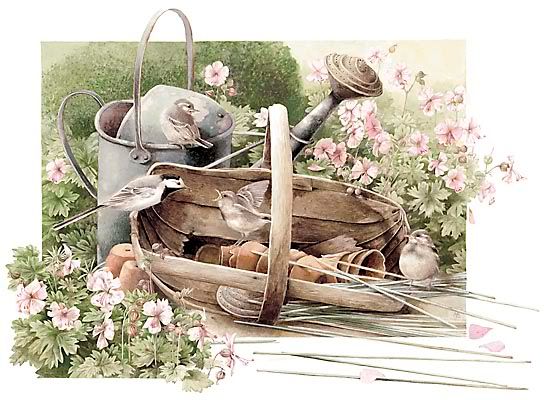
For some reason, I consistently get people coming to my blog who are searching for information on Marjolein Bastin. I'm not sure why--I've never actually done a post on her artwork! Maybe search engines read minds--I really do enjoy her artwork, and have since I first saw her greeting cards at Hallmark (I'll even confess that as a kid I owned several of her T-shirts). I fell in love with Edith Holden's Country Diary of a Victorian Lady at about the same time, and Bastin's watercolours have many similar qualities, which is probably why I was so drawn to them. 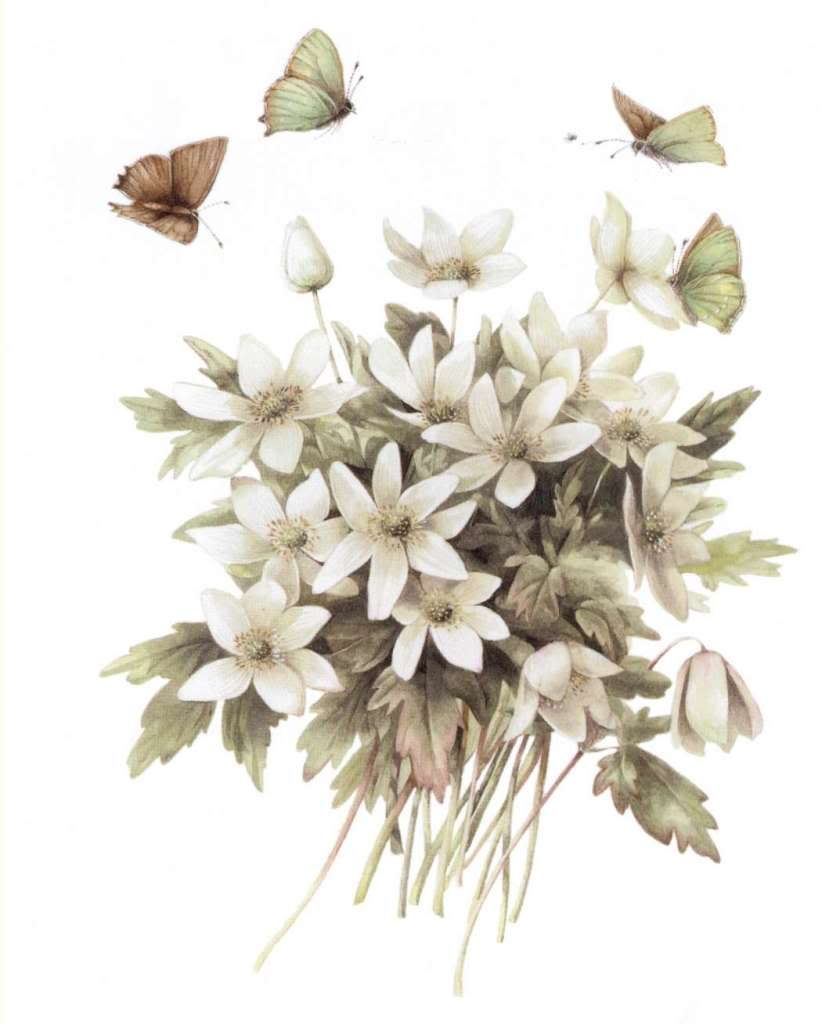
Marjolein Bastin is a very commercial artist, but I really like her work. Her nature drawings and children's books have a charming, sweet quality and reflect an honest appreciation for nature. Bastin is originally from Utrecht, Netherlands and today she and her family split their time between Holland, Missouri (near Hallmark headquarters) and the Cayman Islands. Her "Nature's Sketchbook" line is probably my favourite thing at Hallmark, and is consistently one of their best sellers (hence her vacation home in the Caymans). Her delightfully illustrated children's books about "Vera the Mouse" are just darling.
You can buy Marjolein Bastin's stationary from Amazon, or through her own website, which has great information on the artist and a large selection of her work available for purchase.
Posted by
Margaret
at
7:43 AM
5
comments
![]()
![]()
Labels: reviews
Monday, May 5, 2008
A Few Newly Discovered Websites

I hope everyone had a good weekend! I've been insanely busy editing my thesis for the past several weeks, and it looks like this week will be the craziest so far.
Today I thought I'd introduce a couple of blogs that I've come across in the past couple of weeks.
The first is Owl's Farm. This blog is "Inspired by William Morris, the Farm consists a series of musings about utopia: eutopia, outopia, dystopia, and how to keep going amidst it all." I really enjoy reading Candace's thoughtful reflections on Morris (she's even written a News from Nowhere-inspired Utopian novel entitled More News from Nowhere, which she's made available free online).
Secondly, I recently discovered that the William Morris Society has a blog! They've only been online for a couple of months, but I'm sure that this will be a good site to get information on the latest William Morris/Arts and Crafts/Pre-Raphaelite related news.
Last, but by no means least, I just found Gillian's Reflections in the Afternoon yesterday. It is an absolutely lovely blog that I plan on visiting regularly! Be sure and check it out! I really enjoyed her April 30th post on The Lion the Witch and the Wardrobe.
Posted by
Margaret
at
7:35 AM
3
comments
![]()
![]()
Labels: reviews, william morris
Saturday, May 3, 2008
William Morris' Daisy Wallpaper
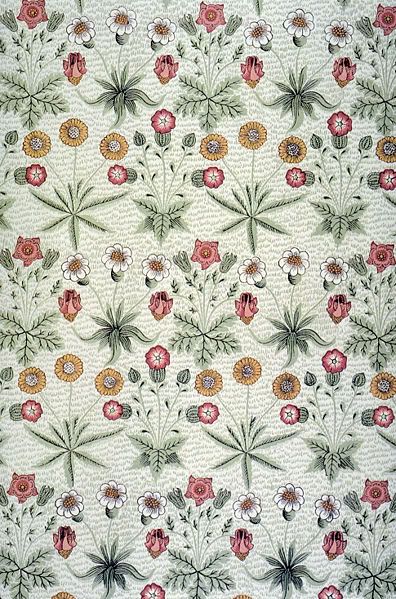
Morris designed both Daisy and Trellis in the early 1860s while he and his family were living at Red House, thought the designs were not officially registered until February 1864. Morris and Company was in its very early stages at that time and so the wallpaper blocks were manufactured for Morris by Jeffrey & Company of Islington, London. The design is made up of four clumps of flowers that are arranged on horizontal lines.
The design for Daisy was inspired either by a daisy wallhanging Jane Morris embroidered, or by an illumination in a medieval manuscript (Froissart's Chronicles)--no-one is absolutely sure.
Whatever the inspiration for the design, it is clear that Morris was influenced by medieval artwork. "Daisy" utilizes some of the medieval design elements discussed by
In "Of Medieval Landscapes" John Ruskin observed that medieval art paid attention to "what was graceful, symmetrical, and bright in colour," and that artists in the Middle Ages tended to reduce the complexity of floral elements to "disciplined and orderly patterns." Daisy demonstrates adhereance to this and other medieval design principles, including the "law of growth" (by showing the buds developing on the plants) and "the law of proportion," which can be seen in the symmetry of the plants (for example, each plant has three flowers and an equal number of leaves).
Personally, I'm not sure what I think about all this symmetry! I love the elements in both "Daisy" and "Trellis," but when they're on a wall it can be a bit overwhelming. I think it's interesting to note that while Morris designed many wallpapers, he used them somewhat sparingly in his own home.
Sources consulted: William Morris Gallery and Writing on the Image: Reading William Morris
Daisy Wallpaper courtesy wikimedia commons
Posted by
Margaret
at
11:35 AM
1 comments
![]()
![]()
Labels: decorating, jane morris, william morris
Fountain Pens Boost Self-Esteem
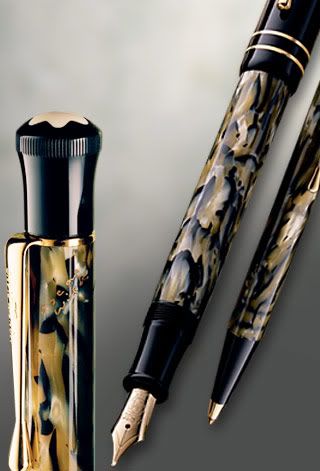
It should come as no surprise to those of us who stubbornly cling to our lovely fountain pens, but according to the BBC, fountain pens help boost student's self-esteem!
Stewart's Melville Junior School in Edinburgh has found that students who use fountain pens write more neatly, which makes their papers easier to mark. As a result, the students feel more confident about their writing, which helps their overall self-esteem.
I think fountain pens help my self-esteem, but not because I write more beautifully when I use one (although that may be true). Fountain pens are beautiful, and when I use one, I immeadiately feel like whatever I'm writing is more valuable. It's harder to write junk with a fountain pen, and even if it is junk, it doesn't feel like it. It's hard to explain.
I still remember my first fountain pen. I got it from my mom as a birthday present. It was a Sheaffer and came in a kit that included tubes of ink in all sorts of exciting colours (I adored the aqua blue--I wanted to write everything in it). I recall how excited I was to practice my letters and to copy all of the beautiful alphabets included in the instruction booklet. Something about having a special instrument to write with made words so much more exciting.
These days I drool over Montblanc's writer's edition pens (the Oscar Wilde is pictured). They are to die for. Heaven knows how much they cost, but one can dream!
Posted by
Margaret
at
10:21 AM
5
comments
![]()
![]()
Friday, May 2, 2008
Le Divorce

In preparation for my trip to Paris in May, I re-watched all of my favourite Paris-themed films, including Merchant Ivory's 2003 Romantic Comedy, Le Divorce. The film is generally poo-poohed by Merchant Ivory buffs, who consider it vastly inferior to Howard's End, Remains of the Day and A Room with a View, but I still love it.
Le Divorce is one of those films that everyone seems to love to hate. It's certainly a departure from the costume-drama romps that are characteristic of Merchant Ivory. It also panders to a rather one-dimensional stereotype of french people that has been all the rage since, say, the end of the second world war. The filmmakers would have you believe that all the french dress fabulously, are passionately involved in progressive causes, have five-course meals 3 times a day, that french women spend their days shopping for fancy lingerie, are never fat and their primary concern in life is contemplating their next romantic encounter, etc, etc.
If you have been to France, or know any real French people, you probably have discovered that life in France (even Paris) isn't exactly a Charles Trenet bistro tune. And sorry to burst your bubble, but the book French Women Don't Get Fat is a bit of myth. It should be called "French Women who are CEOs of Veuve Clicquot Don't Dare Get Fat" (you may have heard that Mireille Guiliano, author of French Women Don't Get Fat, is the CEO of Clicquot, Inc. and a senior executive at LVMH--that's Louis Vuitton Moet Hennessey). There are tons chubby ladies in Paris, just like anywhere else in the world, though there are less than in North America, which is probably due to the fact that France simply doesn't offer as much temptation in the way of fast-food restaurants).
While Le Divorce offers up more than its fair share of hopelessly outmoded stereotypes, the scenes of Paris and the french countryside make this film worth seeing. Paris has come to symbolise, in the minds of women everywhere, a sort of paradise where everyone and everything is beautiful.
Posted by
Margaret
at
11:36 AM
0
comments
![]()
![]()
Rossetti Poem "Genius in Beauty"
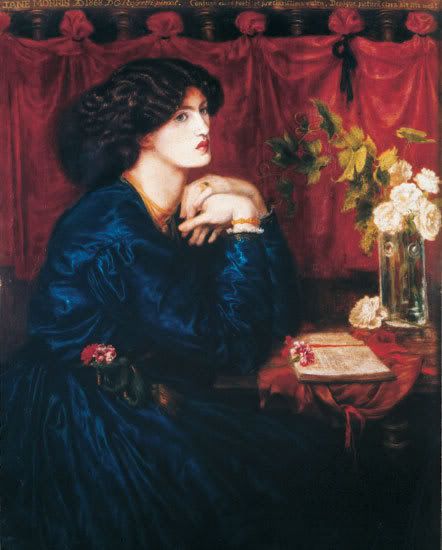
While Dante Gabriel Rossetti is best known today for his contribution to Pre-Raphaelite art, in his own day he was celebrated for his poetry. In an interesting twist, his sister Christina Rossetti is now the better known poet in the family--something that would come as a bit of a surprise to both of them if they were alive today!
Dante Gabriel Rossetti's poetry was praised for its passion and drama and he was only 20 years old when his poem "The Blessed Damozel" won critical acclaim.
One of my favourite Rossetti poems is Genius in Beauty, which was published as part of his collection The House of Life in 1870. I suppose I'm comforted by the idea that some beauty cannot by marred by age! I think the poem refers to Jane--I have a hard time picturing Lizzie Siddal as having a "sovereign face" (my apologies, Lizzie lovers!).
Genius in Beauty
Beauty like hers is genius. Not the call
Of Homer's or of Dante's heart sublime, --
Not Michael's hand furrowing the zones of time, --
Is more with compassed mysteries musical;
Nay, not in Spring's Summer's sweet footfall
More gathered gifts exuberant Life bequeaths
Than doth this sovereign face, whose love-spell breathes
Even from its shadowed contour on the wall.
As many men are poets in their youth,
But for one sweet-strung soul the wires prolong
Even through all change the indomitable song;
So in likewise the envenomed years, whose tooth
Rends shallower grace with ruin void of truth,
Upon this beauty's power shall wreak no wrong.
Dante Gabriel Rossetti
Posted by
Margaret
at
7:20 AM
1 comments
![]()
![]()
Labels: jane morris, poetry, pre-raphaelites, rossetti
Thursday, May 1, 2008
The First Issue of the Art History Carnival
Welcome to the May 1, 2008 edition of the Art History Carnival. I'm really excited to start doing this! We had some really good submissions this month--I can't wait to see what people write next!
art history
I just discovered Sheramy's blog the other day while doing research for my trip to France this month. Sheramy is an Art Historian and her blog, Van Gogh's Chair, is a spectacular resource for information on Van Gogh's life and work. Readers will appreciate her recent post on Van Gogh's Night Cafe which examines several of the stories behind the painting.
Jason submitted a fasinating post on the interaction of art and history entitled1457: László Hunyadi, the death before Hungary’s rebirth this piece examines how artists in the 19th century interpreted the death of a fiture from 15th century Hungarian history. It is posted at Executed Today.
Nigel Beale's post on 19th century French artist Gustave Courbet (considered by some to be the father of modernism) provides a great background on the artist and his work. It's a great peace of art history! NIGEL BEALE NOTA BENE BOOKS » Blog Archive » Gustave Courbet posted at NIGEL BEALE NOTA BENE BOOKS.
exhibits
So many amazing art exhibits around the world--so little time! These posts offer a look at these exhibitions through the eyes of another blogger. Enjoy!
First we travel to Berlin's Neue Nationalgalerie for a tour of their spectacular 20th Century Art Collection. Diane Marie Feucht shares her impressions of the Neue Nationalgalerie on her Art Blog .
Leslie Carbone presents a post on the National Art Gallery at the Smithsonian Museum. I really enjoyed reading her reaction to Vincent Van Gogh's "Vase With Roses"--especially since I may be visiting Arles this month--the town where he painted many of his most famous works! The post, entitled Smithsonian Museums is at her website Leslie Carbone.
Barb presents a post on her recent visit to the University of Arizona's Art Museum and her thoughts on the futuristic art of Robert McCall in The Heart of Harmony - Art Has Amazing Power posted at The Heart of Harmony - Homeschool Blogger, saying, "We just recently visited the Tucson, AZ area and had the pleasure of viewing Robert McCall's paintings. Our whole family enjoyed the experience and were inspired to come home and learn some more.
Finally, a post examining the lighter side of art--Baltimore's Kinetic Sculpture Race, in which contestants must fashion their own mobile art objects and race them to the finish line! Form and function working together in an amusing, if not highly practical, way. Jon Rochetti presents Strangest Race Ever posted at The DC Traveler – Washington DC travel & tourism information, saying, "nicknamed the “Triathlon of the Art World“, the Kinetic Sculpture Race in Baltimore is one of the wackiest art exhibits and races in America."
That concludes this edition. Submit your blog article to the next edition of the
Art History Carnival
using our
carnival submission form.
Past posts and future hosts can be found on our
blog carnival index page.
Technorati tags:
art history carnival, blog carnival.
Posted by
Margaret
at
7:29 AM
5
comments
![]()
![]()
Labels: blog carnival

